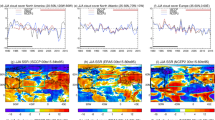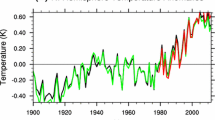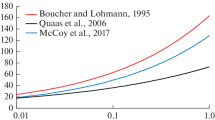Abstract
Among anthropogenic perturbations of the Earth’s atmosphere, greenhouse gases and aerosols are considered to have a major impact on the energy budget through their impact on radiative fluxes. We use three ensembles of simulations with the LMDZ general circulation model to investigate the radiative impacts of five species of greenhouse gases (CO2, CH4, N2O, CFC-11 and CFC-12) and sulfate aerosols for the period 1930–1989. Since our focus is on the atmospheric changes in clouds and radiation from greenhouse gases and aerosols, we prescribed sea-surface temperatures in these simulations. Besides the direct impact on radiation through the greenhouse effect and scattering of sunlight by aerosols, strong radiative impacts of both perturbations through changes in cloudiness are analysed. The increase in greenhouse gas concentration leads to a reduction of clouds at all atmospheric levels, thus decreasing the total greenhouse effect in the longwave spectrum and increasing absorption of solar radiation by reduction of cloud albedo. Increasing anthropogenic aerosol burden results in a decrease in high-level cloud cover through a cooling of the atmosphere, and an increase in the low-level cloud cover through the second aerosol indirect effect. The trend in low-level cloud lifetime due to aerosols is quantified to 0.5 min day−1 decade−1 for the simulation period. The different changes in high (decrease) and low-level (increase) cloudiness due to the response of cloud processes to aerosols impact shortwave radiation in a contrariwise manner, and the net effect is slightly positive. The total aerosol effect including the aerosol direct and first indirect effects remains strongly negative.










Similar content being viewed by others
References
Albrecht BA (1989) Aerosols, cloud microphysics, and fractional cloudiness. Science 245:1227–1230
Boucher O, Anderson TL (1995) General circulation model assessment of the sensitivity of direct climate forcing by anthropogenic sulfate aerosols to aerosol size and chemistry. J Geophys Res 100:26117–26134
Boucher O, Haywood J (2001) On summing the components of radiative forcing of climate change. Clim Dyn 18:297–302
Boucher O, Lohmann U (1995) The sulfate-CCN-cloud albedo effect—a sensitivity study with two general circulation models. Tellus 47B:281–300
Boucher O, Pham M (2001) History of sulfate aerosol radiative forcings. Geoph Res Lett 29:1308. DOI 1029/2001GL014048
Boucher O, Le Treut H, Baker MB (1995) Precipitation and radiation modeling in a general circulation model: introduction of cloud microphysical processes. J Geophys Res 100:16395–16414
Boucher O, Pham M, Venkataraman C (2002) Simulation of the atmospheric sulfur cycle in the Laboratoire de Météorologie Dynamique general circulation model. Model description, model evaluation, and global and European budgets. In: Boulanger J-P, Li Z-X (eds) Note scientifique de l’IPSL 23. IPSL, Paris
Brenguier J-L, Chuang P, Fouquart Y, Johnson DW, Parol F, Pawlowska H, Pelon J, Schüller L, Schröder F, Snider J (2000) An overview of the ACE-2 CLOUDYCOLUMN closure experiment. Tellus 52B:815–827
Bréon F-M, Tanré D, Generoso S (2002) Aerosol effect on cloud droplet size monitored from satellite. Science 295:834–838
Cess RD, Zhang M-H, Potter GL, Barker HW, Colman RA, Dazlich DA, DelGenio AD, Esch M, Fraser JR, Galin V, Gates W, Hack JJ, Ingram JW, Kieht JT, Lacis AA, Le Treut H, Li Z-X, Liang X-Z, Mahfouf J-F, McAvaney BJ, Meleshko VP, Morcrett J-J, Randall DA, Roeckner E, Royer J-F, Sokolov AP, Sporyshev PV, Taylor KE, Wang W-C, Wetherald RT (1993) Uncertainties in carbon dioxide radiative forcing in atmospheric general circulation models. Science 262:1252–1255
Charlson RJ, Lovelock JE, Andrae MO, Warren SG (1989) Sulphate aerosols and climate. Nature 340:437–438
Coakley JA Jr, Bernstein RL, Durkee PA (1987) Effect of ship-track effluents on cloud reflectivity. Science 237:1020–1022
Folland CK, Karl TR, Christy RA, Gruza GV, Jouzel J, Mann ME, Oerlemans J, Salinger MJ, Wand S-W (2001) Oberved climate variability and climate change. In: Houghton JT, Ding Y, Griggs DJ, Noguer M, van der Linden PJ, Dai X, Maskell K, Johnson DJ (eds) Climate change 2001—the scientific basis. Contribution of working group I to the Third Assessment Report of the Intergovernmental Panel on Climate Change. Cambridge University Press, Cambridge, pp 99–182
Fouquart Y, Bonnel B (1980) Computations of solar heating of the Earth’s atmosphere: a new parameterization. Cont Atmos Phys 53:35–62
Hansen J, Sato M, Ruedy R (1997) Radiative forcing and climate response. J Geophys Res 102:6831–6864
Kaufman YJ, Nakajima T (1993) Effect of Amazon smoke on cloud microphysics and albedo—analysis from satellite imagery. J Appl Meteorol 32:729–744
Le Treut H, Li X-Z (1991) Sensitivity of an atmospheric general circulation model to prescribed SST changes: feedback effects associated with the simulation of cloud optical properties. Clim Dyn 5:175–187
Le Treut H, Forichon M, Boucher O, Li Z-X (1998) Sulfate aerosol indirect effect and CO2 greenhouse forcing: equilibrium response of the LMD GCM and associated cloud feedbacks. J Clim 11:1673–1684
Li Z-X (1999) Ensemble atmospheric GCM simulation of climate interannual variability from 1979 to 1994. J Clim 12:986–1001
McAvaney BJ, Covey C, Joussaume S, Kattsov V, Kitoh A, Ogana W, Pitman AJ, Weaver AJ, Wood RA, Zhao Z-C (2001) Model evaluation. In: Houghton JT, Ding Y, Griggs DJ, Noguer M, van der Linden PJ, Dai X, Maskell K, Johnson DJ (eds) Climate change 2001—the scientific basis. Contribution of working group I to the Third Assessment Report of the Intergovernmental Panel on Climate Change. Cambridge University Press, Cambridge, pp 471–524
Mitchell JFB, Karoly DJ, Hegerl GC, Zwiers FW, Allen MR, Marengo J (2001) Detection of climate change and attribution of causes. In: Houghton JT, Ding Y, Griggs DJ, Noguer M, van der Linden PJ, Dai X, Maskell K, Johnson DJ (eds) Climate change 2001—the scientific basis. Contribution of working group I to the Third Assessment Report of the Intergovernmental Panel on Climate Change. Cambridge University Press, Cambridge, pp 695–738
Morcrette J-J (1991) Evaluation of model-generated cloudiness: Satellite-observed and model-generated diurnal variability of brightness temperature. Mon Wea Rev 119:1205–1224
Myhre G, Myhre A, Stordal F (2001) Historical evolution of radiative forcing of climate. Atmos Environ 35:2361–2373
Pontikis CA, Hicks EM (1993) Droplet activation as related to entrainment and mixing in warm tropical marine clouds. J Atmos Sci 50:1888–1896
Ramanathan, Crutzen P, Lelieveld J, Mitra AP, Althausen D, Anderson J, Andrae MO, Cantrell W, Cass GR, Chung CE, Clarke AD, Coakley JA Jr, Collins WA, Conant WC, Dulac F, Heintzenberg BJ, Heymsfield AJ, Holben B, Howell S, Hudson CJ, Jayaraman A, Kiehl JT, Krishnamurti TN, Lubin DD, McFarquhar G, Novakov T, Ogren J, Poddorny EIA, Prather K, Priestly K, Prospero JM, Quinn FPK, Pajeev K, Rasch P, Rupert S, Sadourny R, Satheesh GSK, Shaw GE, Sheridan P, Valero FPJ (2001) Indian ocean experiment: an integrated analysis of the climate forcing and effects of the great Indo-Asian haze. J Geophys Res 106:28371–28398
Ramaswamy V, Boucher O, Haigh J, Hauglustaine D, Haywood J, Myhre G, Nakajima T, Shi GY, Solomon S (2001) Radiative forcing of climate change. In Houghton JT, Ding Y, Griggs DJ, Noguer M, van der Linden PJ, Dai X, Maskell K, Johnson DJ (eds) Climate change 2001—the scientific basis. Contribution of working group I to the Third Assessment Report of the Intergovernmental Panel on Climate Change. Cambridge University Press, Cambridge, pp 349–416
Rayner NA, Parker DE, Horton EB, Folland CK, Alexander LV, Rowell DP, Kent EC, Kaplan A (2003) Global analyses of SST, sea ice and night marine air temperature since the late nineteenth century. J Geophys Res 108:4407. DOI 10.1029/2002JD002670
Rosenfeld D (2000) Suppression of rain and snow by rban and industrial air pollution. Science 287:1793–1796
Rotstayn LD, Penner JE (2001) Indirect aerosol forcing, quasi-forcing and climate response. J Clim 14:2960–2975
Sexton DMH, Grubb H, Shine KP, Folland CK (2003) Design and analysis of climate model experiments for the efficient estimation of anthropogenic signals. J Clim 16:1320–1336
Stephens GL (1978) Radiation profiles in extended water clouds. II: parameterization schemes. J Atmos Sci 35:2123–2132
Tiedtke M (1989) A comprehensive mass flux scheme for cumulus parameterization in large-scale models. Mon Wea Rev 117:1779–1800
Twomey S (1974) Pollution and the planetary albedo. Atmos Environ 8:1251–1256
Wigley TML (1989) Possible climate change due to SO2-derived cloud condensation nuclei. Nature 339:365–367
Acknowledgements
The SST and sea ice extent data were provided by Dr. Nick Rayner of the Hadley Centre. GHG concentration data are from Dr. Gunnar Myhre of the Department for Geophysics, University of Oslo. Computer time was provided by Institut de Développement et des Resources en Informatique Scientifique (IDRIS) of the CNRS. We thank Dr. Zhao-Xin Li for many helpful discussions.
Author information
Authors and Affiliations
Corresponding author
Rights and permissions
About this article
Cite this article
Quaas, J., Boucher, O., Dufresne, JL. et al. Impacts of greenhouse gases and aerosol direct and indirect effects on clouds and radiation in atmospheric GCM simulations of the 1930–1989 period. Climate Dynamics 23, 779–789 (2004). https://doi.org/10.1007/s00382-004-0475-0
Received:
Accepted:
Published:
Issue Date:
DOI: https://doi.org/10.1007/s00382-004-0475-0




